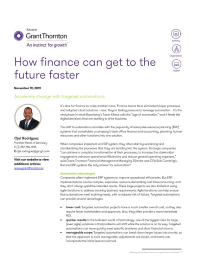-
Financial statements audits
Financial statement audits
-
Compliance audits
Compliance audits
-
Compilations and reviews
Compilations and audit
-
Agreed-upon procedures
Agreed-upon procedures
-
Corporate and business tax
Our trusted teams can prepare corporate tax files and ruling requests, support you with deferrals, accounting procedures and legitimate tax benefits.
-
International tax
Our teams have in-depth knowledge of the relationship between domestic and international tax laws.
-
Tax compliance
Business Tax
-
Individual taxes
Individual taxes
-
Estate and succession planning
Estate and succession planning
-
Global mobility services
Through our global organisation of member firms, we support both companies and individuals, providing insightful solutions to minimise the tax burden for both parties.
-
Sales and use tax and indirect taxes
SUT/ VAT & indirect taxes
-
Tax incentives program
Tax incentives program
-
Transfer Pricing Study
The laws surrounding transfer pricing are becoming ever more complex, as tax affairs of multinational companies are facing scrutiny from media, regulators and the public
-
Business consulting
Our business consulting services can help you improve your operational performance and productivity, adding value throughout your growth life cycle.
-
Forensic and investigative services
At Grant Thornton, we have a wealth of knowledge in forensic services and can support you with issues such as dispute resolution, fraud and insurance claims.
-
Fraud and investigations
The commercial landscape is changing fast. An ever more regulated environment means organizations today must adopt stringent governance and compliance processes. As business has become global, organizations need to adapt to deal with multi-jurisdictional investigations, litigation, and dispute resolution, address the threat of cyber-attack and at the same time protect the organization’s value.
-
Dispute resolutions
Our independent experts are experienced in advising on civil and criminal matters involving contract breaches, partnership disputes, auditor negligence, shareholder disputes and company valuations, disputes for corporates, the public sector and individuals. We act in all forms of dispute resolution, including litigation, arbitration, and mediation.
-
Business risk services
We can help you identify, understand and manage potential risks to safeguard your business and comply with regulatory requirements.
-
Internal audit
We work with our clients to assess their corporate level risk, identify areas of greatest risk and develop appropriate work plans and audit programs to mitigate these risks.
-
Service organization reports
As a service organization, you know how important it is to produce a report for your customers and their auditors that instills confidence and enhances their trust in your services. Grant Thornton Advisory professionals can help you determine which report(s) will satisfy your customers’ needs and provide relevant information to your customers and customers’ auditors that will be a business benefit to you.
-
Transaction advisory services
Transactions are significant events in the life of a business – a successful deal that can have a lasting impact on the future shape of the organizations involved. Because the stakes are high for both buyers and sellers, experience, determination and pragmatism are required to bring deals safely through to conclusion.
-
Mergers and acquisitions
Globalization and company growth ambitions are driving an increase in M&A activity worldwide as businesses look to establish a footprint in countries beyond their own. Even within their own regions, many businesses feel the pressure to acquire in order to establish a strategic presence in new markets, such as those being created by rapid technological innovation.
-
Valuations
We can support you throughout the transaction process – helping achieve the best possible outcome at the point of the transaction and in the longer term.
-
Recovery and reorganization
We provide a wide range of services to recovery and reorganisation professionals, companies and their stakeholders.
Accelerate change with targeted automations
It’s time for finance to make another move. Finance teams have eliminated paper processes and adopted cloud solutions – now, they’re feeling pressure to leverage automation. It’s the next phase in what Bloomberg’s Taran Khera calls the “age of automation,” and it feeds the digital decisions that are starting to drive business.
The shift to automation coincides with the popularity of enterprise resource planning (ERP) systems that consolidate a company’s back office finance and accounting, planning, human resources and other functions into one solution.
When companies implement an ERP system, they often start by examining and standardizing the processes that they are building into the system. Strategic companies “can achieve a complete transformation of their processes, to increase the stakeholder engagement, enhance operational efficiencies and reduce general operating expenses,” said Grant Thornton Financial Management Managing Director and CPA Bob Cummings.
But are ERP systems the only answer for automation?
Automation advantages
Companies often implement ERP systems to improve operational efficiencies. But ERP implementations can be complex, expensive, resource-demanding and time-consuming, and they don't always yield the intended results. These large projects are also limited at using agile iterations to address evolving business requirements. Agile iterations can help ensure that automations meet evolving needs, with a reduced risk of failure. Targeted automations can provide several advantages:
- lower cost: Targeted automation projects have a much smaller overall cost, so they also require fewer stakeholders and approvals. Also, they often provide a more immediate ROI.
- quicker results: In the turbulent world of technology, one of the biggest risks for large (even agile) solutions is that problems will shift while the solution is on its way. Targeted automations can more quickly meet specific problems and show financial returns.
- manageable scope: Targeted automations can break down larger issues into chunks, so that the approach is more manageable, adjustments are easier, and teams can incorporate the initial lessons learned.
- targeted resources: With a smaller project size, a targeted automation is less of a burden on the organization’s resources. The project can glean specific knowledge from the best in-house subject matter experts and can be implemented by the people most invested in the result. Companies can use business-as-usual resources in a targeted manner, so that their resources are not stretched too thin across the enterprise.
- visible results: Teams going through the implementation process can readily see the gains from a targeted automation in their area. Most importantly, they can better understand the transformation taking place. When an organization addresses problems in batches, the organization learns how to solve their problems more efficiently and effectively. Visible results also drive cultural change that get organizations to the future faster. “When implementing targeted automations, companies are teaching their teams how to live in the world of automation by bringing them along on the journey, rather than just dropping it on them all at once,” Cummings said.
Automation candidates
How do you know when to use targeted automation, rather than addressing issues with an ERP system? It truly depends on the organization’s scope, timeline, budget and resources. Companies should consider the following:
- the ERP question: Do we have a cost-justified need to standardize and consolidate processes across our enterprise?
- the targeted automation question: Do we have a cost-justified opportunity to automate an inefficient process?
The signs of an inefficient process can be surprisingly clear. “One of the red flags of an inefficient process is excessive use of Excel,” Cummings said. Finance departments often take information from multiple areas and combine it into an Excel workbook to run pivot tables and analyses. This workbook ultimately produces a result either for the business or for the general ledger. This is a sign that teams are using Excel to bridge a functionality gap where systems aren’t integrated. Typically, companies have not integrated the systems due to the anticipated cost and effort of an ERP implementation. However, the organization can consider a targeted automation to both collect and manipulate the data. Targeted automations can help address efficiency, technology limitations, accuracy and other needs, in various areas of the finance function.
Efficiency in policy administration and billing
Targeted automation where internal systems are synchronized on the same information, and customers receive the correct and current details, is the ultimate goal.
Technology in cash suspense and cash application
Multi-system coordination is essential to ensuring that funds are quickly and correctly tracked and allocated.
Automation flexibility
ERP systems are powerful, and they are often an excellent long-term goal, but their implementation can place high demands on time, budgets and resources. That’s why many companies are automating processes with targeted solutions. Small targeted solutions can be easier to edit and replace after they are complete. When companies have new lines of business, or new rules that need to be created, they can change these solutions rather than having someone design a new system for the new rules. For companies with an existing ERP, targeted automations can even extend the life of the system.
If a typical ERP has a functional lifespan of seven to ten years, a company can gain another five years of effective life by improving the environment around the ERP with automation solutions. Implementing the right technology is critical to institutionalizing processes so that they can be performed by anyone in the organization. With a manageable size, comparatively quick results and dynamic flexibility, targeted automations are an essential option to consider.
Source
Grant Thornton library articles: How finance can get to the future faster
We are committed to keep you updated of all developments that may affect the way you do business in Puerto Rico. Please contact us for assistance in relation to this or any other matter, we will be glad to assist you.


